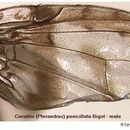Ceratitis (Pterandrus) penicillata Bigot
Ceratitis ? penicillatus Bigot, 1891: 381.
Body length: 4.40 (3.90-5.15) mm; wing length: 4.78 (4.45-5.25) mm.
Male
Head:
Antenna yellowish orange, First flagellomere brown; twice or three times as long as pedicel. Arista with moderately long rays; ventral rays shorter and sparser than dorsal rays, especially basally. Frons yellow, sometimes pale yellow; darker patches on ventral half, especially at frontofacial angle; with short scattered setulae largely of same color as frons (occasionally darker). Frontal setae well developed. Face pale, median part with darker yellow to brown patch. Genal seta and setulae dark, well developed. Thorax:
Postpronotal lobe white, without spot. Scutal pattern:
ground color dark gray; with streaks and darker markings but without distinct spots except prescutellar white separate markings, with pale area in between. Scapular setae dark. Scutellum white, basally without spots, apically with three separate black spots, extending to basal half. Anepisternum along ventral margin only brown; setulae pale. Legs:
Yellow except where otherwise noted; setation typical for subgenus, mixed pale and dark. Foreleg:
femur with dorsal part brownish colored anteriorly and posteriorly; posteriorly no bush, only dispersed setulae; ventral setae black. Midleg:
femur anteriorly with large brown patch in median part, basally with few dispersed long pale setulae; tibia moderately broadened and anteriorly brownish black on distal half (except along dorsal row of feathering where yellow covered by short dark setulae), with black feathering ventrally along distal half, dorsally slightly over distal half. Hindleg:
femur brown on dorsal half; at apical 0.25 with longer setulae dorsally and ventrally. Wing:
bands yellowish brown to brown. Marginal band forming continuous band with anterior part of discal band; cubital band free; medial band absent (in rare cases a weak and incomplete band is present); crossvein R-M proximal to middle of discal cell. Apex of vein R1 distal to level of crossvein R-M. Orientation crossvein DM-Cu variable. Abdomen:
Mostly yellow. Tergites 2 and 4 across posterior half with pale gray band. Tergite 3 brown on posterior half. Tergites 4 and 5 along anterior margin yellowish brown, latter posteriorly narrowly brown.
Male epandrium in lateral view with lateral surstylus long and slender; posterior lobe straight and elongate.
Female
As male except for the following characters. First flagellomere darker but not brown. Face without darker coloration in median part. Crossvein DM-Cu oblique anterobasally. Medial band in one paratype of fumitactus weakly present. Legs without feathering, femora yellowish brown; forefemur posteroventrally with pale pilosity. Abdominal tergite 3 sometimes almost completely brown; tergite 5 on anterior 0.33 yellowish brown to brown, posteriorly without brownish margin. Oviscape slightly shorter than preabdomen. Aculeus at least eight times longer than wide; tip with distinct apical indentation and lateral margin weakly sinuous.
(Description after De Meyer & Freidberg, 2006)
See description of Ceratitis penicillata Bigot, 1891 in source PDF.

